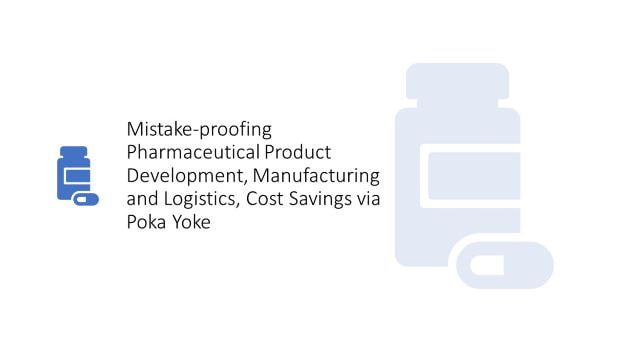- R&D is slow, doesn’t give out products on time?
- Too many backorders, products don’t leave factory on time?
- Too many failed batches in pilot plant during tech-transfer?
- Too many failed bio-studies?
- Accidents at workplaces?
- Cost of logistics is high; denting bottom-line?
If you have any of the above complaints (and more), then this post is for you. Do keep reading…
A point to note is that, defects and rework happen in all areas of a pharmaceutical business, be it- R&D, Manufacturing, Logistics or Office work zones.
In any business, including pharmaceuticals, defects and rework amount from 5% to as much as 30% of overhead expenses. Imagine what if your business could save all those dollars?
Poka Yoke concept was first formalized and adopted in the auto industry to draw attention to human errors as they happen. It was originally described as Baka Yoke; ‘Baka’ in Japanese means an idiot or a fool. Baka Yoke meant idiot-proofing or fool-proofing. The name was later changed to a milder term- Poka Yoke; ‘Poka’ in Japanese means disengaged. Poka Yoke means mistake-proofing or error-proofing. Poka Yoke aims to prevent errors because of actively disengaged employees.
Poka Yoke is preventing errors caused by absent-mindedness. Baka Yoke is preventing errors when process standard is beyond human ability. Poka Yoke distinguishes between concept of inevitable errors (professing Murphy’s Law) and defects that happens because of lax processes and/or absent-mindedness of employees.
The consequence of defects in pharmaceuticals is grave when defective products reach the market- C&F agents, wholesalers, retailers, doctors, patients. Maximum damage is done when defective products are consumed by unsuspecting patients; while damage is minimal when defects are detected no sooner than they occur.
The aim of Poka Yoke is to design the process (within a company) so that mistakes can be prevented or at least detected and corrected immediately so that it is eliminated at source. Poka Yoke can be implemented at any step of a R&D, manufacturing, logistics or office process, that is, all processes where something can go wrong or an error can happen.
How to do Error-Proofing?
Error-proofing in traditional pharma companies can be primarily done via three techniques, namely:
- Contact Method technique: contact method identifies defects by testing and inspection.
- Fixed-value or Constant number technique: This method alerts the employee if a certain number of movements are not made.
- Motion-step or Sequence technique: This technique determines whether the prescribed steps of the process have been followed.
In above instances, the employee is alerted when a mistake is about to be made (referred as warning Poka Yoke) or the Poka Yoke device actually prevents the mistake from being committed (referred as control Poka Yoke). By eliminating defects, the cost of mistakes within the company is reduced/ eliminated.
Note that the error-proofing fronts increase if the organization is a smart factory, industry 4.0, operates as a multi-national or has many product mixes in its portfolio.
Poka Yoke is most effective when processes are accurately mapped. So, how to install Poka Yoke at your workplace?
You may also like to read:
A methodical approach to build up Poka Yoke countermeasures consist of three steps-
- Identify the need.
- Identify possible mistakes, mistake avenues
- Manage mistakes before satisfying the need.
Benefits of Poka Yoke implementation:
A foremost benefit of Poka Yoke solutions is that they don’t let an error happen in a process. Other benefits include:
- Eliminates rework.
- Reduces cost on employee training.
- Reduces product analysis cost.
- Reduces QA/ QC workload.
- Improved productivity from R&D, manufacturing and other divisions of the organization.
- Improved safety at workplace- no personal injury, prevents machine/ facility damage.
- Motivated employees.
- Promotes product innovations and defensive designs: Defensive design is building contingencies in the design to anticipate all potential ways an end-user could misuse or make a mistake. For example, power sockets are often keyed in such a manner to prevent the transposition of live and neutral. The plug is inserted into the socket in a specific orientation; hence the plug is designed so that it is physically impossible to insert the plug incorrectly.
- Immediate action when a problem occurs.
- Unburdens employees from repetitive operations, makes processes ‘Lean’ and efficient- Saves Cost
Learn more about ‘How to mistake-proof your R&D, Manufacturing, Logistics and Office processes and gain quick cost-savings’. Contact Us
Follow Shruti on Twitter, YouTube, LinkedIn
#Manufacturing #ContinuousImprovement #QualityImprovement #Quality #Impurities #ManufacturingManagement #Pharmaceutical #LifeSciences #RiskManagement #Valsartan #Losartan #Irbesartan #MistakeProofing





















